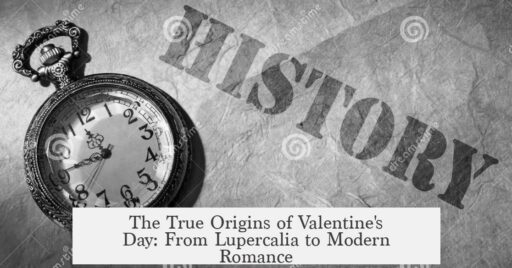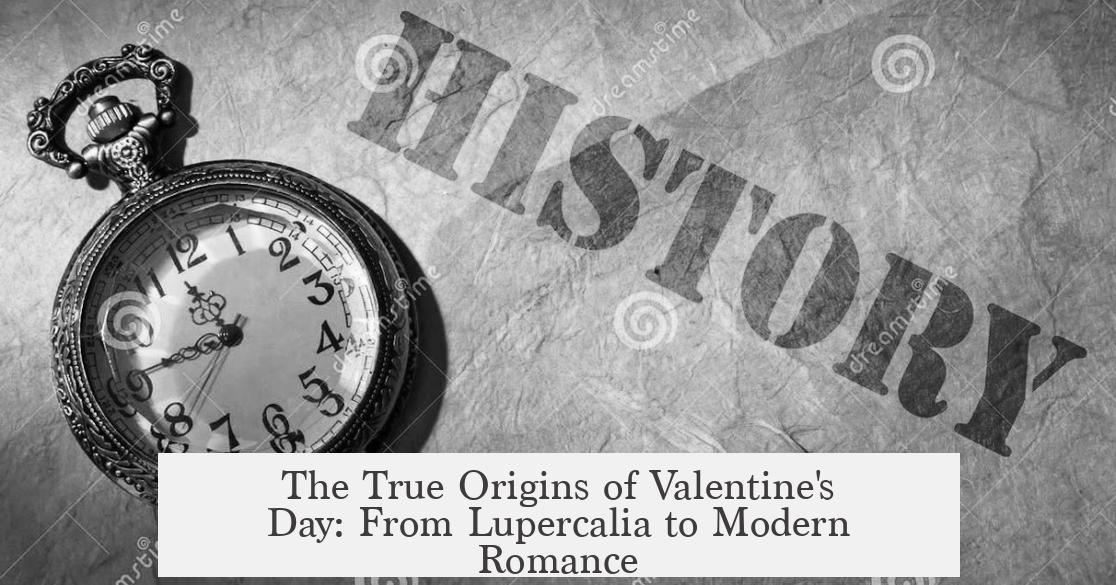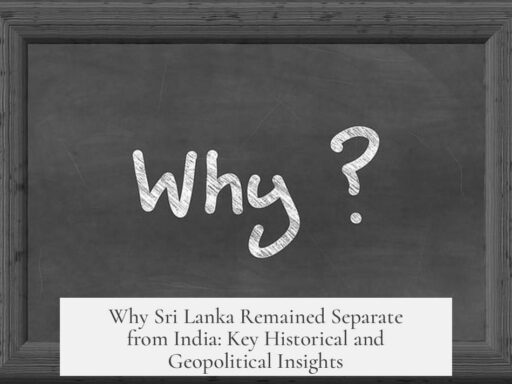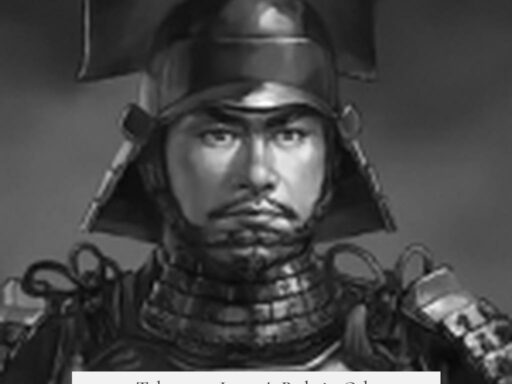The actual origin of Valentine’s Day traces back to the feast day of Saint Valentine, occurring on February 14, with no initial links to romantic love or the ancient Roman festival of Lupercalia. Early celebrations honored one or more Christian martyrs named Valentine, but these events lacked any romantic associations.

Lupercalia, celebrated on February 15, was a Roman festival involving rituals tied to purification. The event included sacrifices of goats and dogs, blood rituals, and the use of goat-hide thongs in ceremonies. These activities served primarily as a lustration ritual to avert evil and did not focus on fertility or romantic themes. Scholars emphasize the clear differences in date, content, and purpose between Lupercalia and Valentine’s Day.
Historical evidence does not support a direct connection between the two. The idea of linking Valentine’s Day to Lupercalia mainly emerged during the eighteenth and nineteenth centuries, without earlier textual or cultural support. Connecting them also presents a significant gap of nearly a thousand years without documented association.

Two primary figures named Valentine appear in Christian traditions, both martyred in Rome during the third century. One was a Roman priest who healed the daughter of his jailer before execution. The other was the Bishop of Terni, who also performed healings and conversions before martyrdom. Both saints are first noted in medieval martyrologies from the sixth and seventh centuries onward. These accounts do not mention any romantic elements.
The connection between Valentine’s Day and romantic love only arose in the late Middle Ages. The earliest recorded link appears in Geoffrey Chaucer’s poem “The Parliament of Fowls,” where the feast day is associated with birds pairing and the arrival of spring. This literary work marks the beginning of Valentine’s Day as a celebration of love and courtship, developing gradually after the saints’ deaths and independently from Lupercalia rituals.

| Aspect | Valentine’s Day | Lupercalia |
|---|---|---|
| Date | February 14 (feast of Saint Valentine) | February 15 (Roman pagan festival) |
| Rituals | Religious martyrdom commemorations | Animal sacrifices, blood rituals, purification ceremonies |
| Original Purpose | Honoring Christian martyrs | Averting evil, purification |
| Romantic Association | Begins late Middle Ages (circa 14th century) | No connection |
- Valentine’s Day originated as a Christian feast day honoring martyrs named Valentine without romantic links.
- Lupercalia was a separate pagan festival involving purification rituals unrelated to love.
- There is no historical evidence directly connecting Valentine’s Day to Lupercalia.
- The romantic association of Valentine’s Day began in the late Middle Ages, notably in Chaucer’s poetry.
What Is the Actual Origin of Valentine’s Day?
Valentine’s Day is not the ancient Roman festival of Lupercalia, nor does it stem directly from any single saint’s romantic legend. Instead, it began simply as the feast day of Saint Valentine on February 14, and only centuries later did it pick up the romantic love vibe we associate with it today. Now that we’ve cleared that up, let’s take a deeper plunge into this holiday’s surprisingly complex and often misunderstood roots.

Valentine’s Day vs. Lupercalia: Two Very Different Parties
First, let’s demystify the grand Roman festival many people love to blame for Valentine’s Day’s origins: Lupercalia. Spoiler alert—it’s not a romantic love fest. Lupercalia took place on February 15 and was anything but sweet and cuddly.

Picture this: Romans slaughtering a dog and some goats at the cave of Lupercal, slapping the blood on two boys’ foreheads with a knife, then setting those boys loose to run around town whipping people with strips of goat hide. If that sounds more like a bizarre ancient torture game than a love celebration, you’re not alone.
This wasn’t about Cupid’s arrows but about purification and warding off evil spirits—essentially ancient spring cleaning with a punch. So while both Valentine’s Day and Lupercalia happen in mid-February, the rituals involved and the meanings behind them couldn’t be more different.
“If Valentine’s Day was in fact connected to Lupercalia,” says historian Jack Oruch, “we would need to explain almost one thousand years of silence,” since Saint Valentine’s feast began long after Lupercalia faded into history. This connection is mostly an 18th- and 19th-century invention, taken for granted but unlikely to hold water.
The Many Valentines Behind February 14
Who was Saint Valentine anyway? Turns out, there might be more than one. At least two Valentines share the February 14 feast day, and their stories are murky at best.
The first Valentine was a Roman priest who supposedly healed the daughter of a man named Asterius and got beheaded by Emperor Claudius II for it. The second Valentine was the Bishop of Terni, who allegedly healed the son of a pagan named Crato and converted his household before his own execution by Roman senators.
Both saints begin showing up in records well after their supposed deaths—the earliest accounts appearing only in the 6th or 7th centuries. Despite their presence throughout medieval Europe, there’s no hint in early records that these Valentines were associated with love or romance.
How Did Romance Get Linked to Valentine’s Day?
This is where the story takes a twist. The romantic associations with Valentine’s Day only appear in the late Middle Ages, more than a thousand years after the saints’ deaths.
We have English poet Geoffrey Chaucer to thank for the first recorded link. In his poem The Parliament of Fowls, written in the 14th century, Chaucer connected the feast day of Saint Valentine with the idea of springtime and love birds pairing up. Here’s the kicker: before this, Valentine’s Day was just another feast day in the Christian calendar—nothing particularly lovey-dovey about it.
So, it’s not a pagan festival turned Christian celebration, nor is it about a saint who boldly defied an emperor for love. The romantic customs we enjoy today developed slowly a millennium later, shaped largely by medieval poets and traditions that assigned Valentine’s Day a new meaning.
Summing It Up: What We Really Know
- February 14 was originally the feast day of Saint Valentine(s), with no romance attached.
- Lupercalia’s rituals are distinct and do not mirror Valentine’s Day traditions.
- Any connection between Lupercalia and Valentine’s Day is a product of later centuries, not historical fact.
- The romantic angle appeared first in the late Middle Ages, thanks to poets like Chaucer.
- No direct historical records link Saint Valentine to romantic traditions.
Why Does It Matter?
Understanding the true roots of Valentine’s Day helps separate fact from fiction. It means that the holiday isn’t just a commercial gimmick or rooted in weird ancient practices, but a blend of Christian tradition and medieval imagination. So next time you send a heart emoji or buy chocolates, you’re participating in a tradition that grew organically over centuries—even if it’s a bit of a historical mashup.
As a practical tip, if you’re curious about other holidays with strange or unclear origins, keep an eye on their celebrated dates and rituals—they often reveal surprises like this.
So, does knowing the origin change your view of Valentine’s Day? Maybe. Or maybe you just keep enjoying the chocolates, cards, and awkward love notes—as we all do. But at least now, you can impress your friends with the fact that Valentine’s Day is much more than ancient Romans whipping each other with goat hides!
What is the real connection between Valentine’s Day and the ancient festival of Lupercalia?
Lupercalia was a Roman festival held on February 15 with rituals involving animal sacrifices and purification. It focused on cleansing and protection, not romantic love. The commonly assumed link to Valentine’s Day is weak and mostly developed in the 18th and 19th centuries.
Who was St. Valentine, and did he have any ties to romantic love?
Several Valentines lived around the 3rd century, including a Roman priest and a bishop. Both were martyred but early records and stories about them have no mention of romance. The romantic link came much later, during the Middle Ages.
When did Valentine’s Day start being associated with love and romance?
The idea of Valentine’s Day as a celebration of romantic love emerged in the late Middle Ages. The first clear connection comes from Geoffrey Chaucer’s writing in the 14th century, linking the feast day to springtime and courtly love traditions.
Why is there almost a thousand-year gap if Valentine’s Day is linked to Lupercalia?
If Valentine’s Day stemmed from Lupercalia, historical records would show continuous or connected observances. Instead, the ancient festival ended long before Valentine’s Day gained any romantic meaning, leaving a large gap with no clear cultural transmission.
Are the stories about St. Valentine reliable sources for the holiday’s origin?
The earliest accounts of St. Valentine appear centuries after their supposed lives. These medieval narratives focus on their martyrdom and miracles, but do not mention any love or romance, which only appeared in later traditions.




